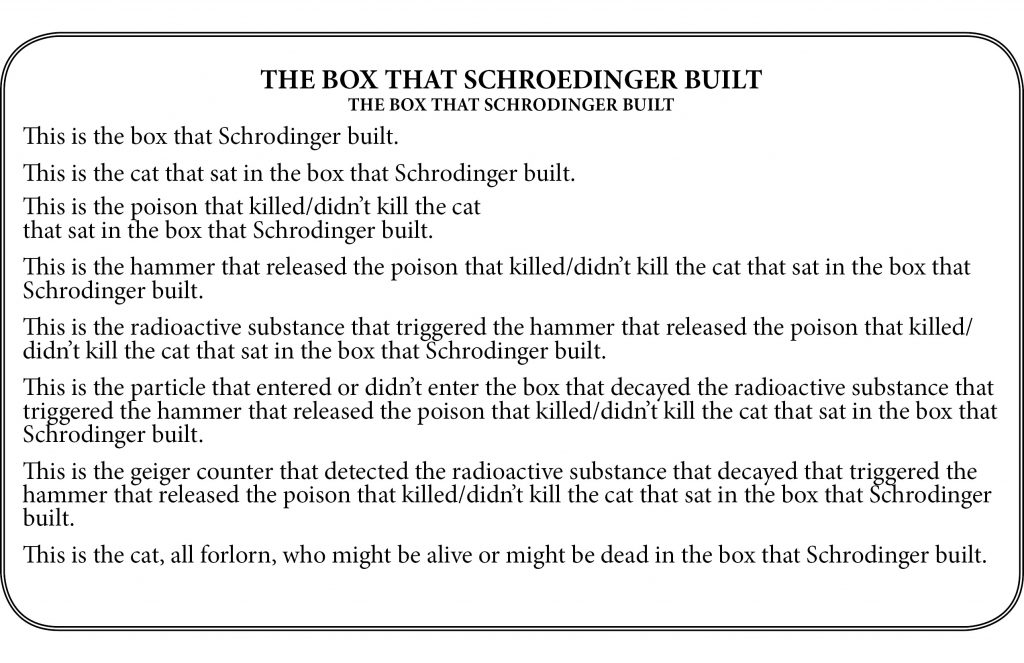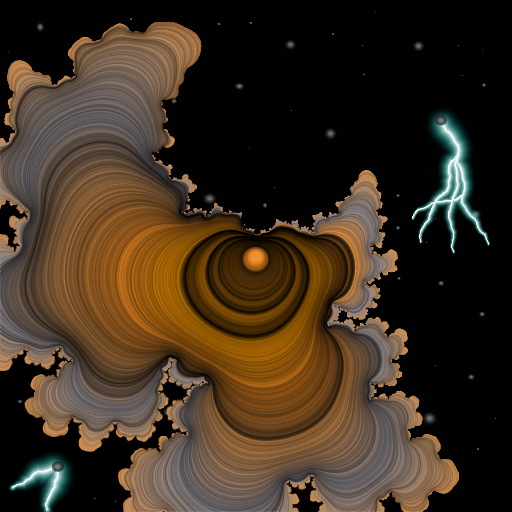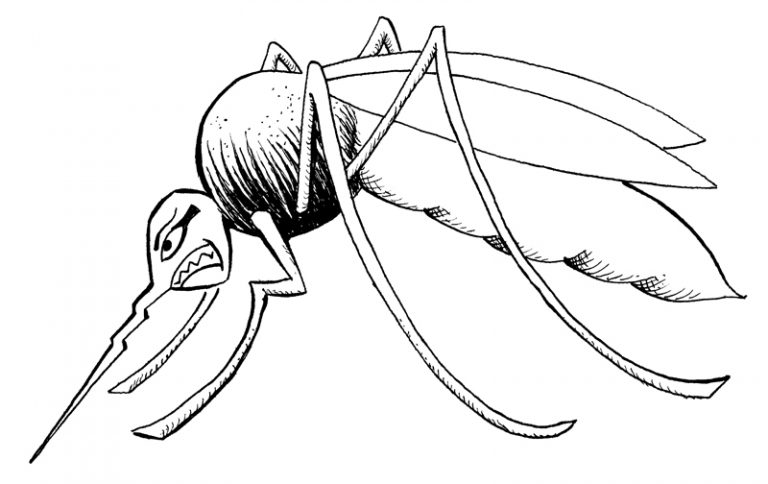Does matter exist? Scientists are not so sure.
Bizarre discoveries of quantum mechanics blow away the solid understanding on which our classical scientific thinking is based. It’s like the ground underneath of us is shifting.
Imagine looking down at the balcony you’re standing on high above the ground. As you look at the boards below your feet you recognize that the atoms that make up the structure—each and every one of them—is 99.999999999999% empty. You are standing on mostly nothing. What supports you?
A quantum physicist might propose that you’re suspended over the atoms that form the deck, hovering over them by the power of repulsion (like opposite magnetic pull, a repulsive force that gives the illusion of solidity). According to physicist and father of quantum theory Max Planck you’re not “standing” on anything “solid” at all.
“As a man who has devoted his whole life to the most clear headed science, to the study of matter, I can tell you as a result of my research about atoms this much: There is no matter as such. All matter originates and exists only by virtue of a force which brings the particle of an atom to vibration and holds this most minute solar system of the atom together. We must assume behind this force the existence of a conscious and intelligent mind. This mind is the matrix of all matter.” ~ Max Planck
Mind is the matrix of all matter? I think I saw that movie. So, if there’s no matter (no spoon), then wha????
With the discovery of the emptiness of the atom, many scientists believed that it was time to get to the bottom of things—to identify the smallest bits of stuff. Quantum mechanics is the study of little stuff, what it is made of and how it behaves. Scientists looked at smaller and smaller matter until—bam! They discovered something other than matter—matter revealed itself to be waves of probability.
Our perception of the world has evolved quite a lot over time. After all, people used to think the Earth was flat. Over the past century, the discovery and understanding of special relativity and quantum mechanics have changed our perception of what is real yet again.
Isaac Newton studied the stuff of our world and gave us the laws of physical objects in motion. He would never have believed that our universe and its contents were anything other than what they appear to be—material things.
Albert Einstein gave us special relativity, the understanding that space and time are relative to each other and are really one thing: spacetime. He could never wrap his head around what he called, “spooky action at a distance”— entangled particles as described by quantum mechanics; the same entangled particles that make super-accurate clocks and uncrackable codes today.
Because of Einstein, our view of the universe changed from the Newtonian picture of a constant, steady vastness populated by chartable stars and planets to a dynamic, ever expanding, ever evolving, curvy-bendy unfolding. Dr. Nima Arkani-Hamed, Institute for Advanced Study, points out:
“The distance between two galaxies grows with time. But the galaxies are not rushing apart from each other into some preexisting space, as though blown out of an explosion from some common center. Rather, more and more space is being generated between the galaxies all the time, so from the vantage point of any one galaxy, the others appear to be rushing away.”
Because of quantum mechanics, our view of the universe is changing from a picture of a pre-determined (no free-will) physical reality populated by things we can measure and experimental results we can foretell, to an unfathomable world of probability promising endless possibility.
Quantum mechanics made a mirage of Newton’s picture of the universe. It melted his clock-like, mechanical view of the world like a Salvador Dali painting.
You might want to dismiss quantum mechanics and maintain a more comfortable view of the universe, as Einstein did, but you’d have to give up a lot of things you now take for granted: your cell phone & tablet, the LASIK surgery that fixed your eyesight, and every other electronic device that powers our 21st Century world.
The math of quantum physics is very, very accurate. Experiments done based on this math reveal a strange, unruly world, far different than the one described by Newton or Einstein. The quantum world is different from the classical world in four specific, testable ways: the wave/particle chicanery, the measurement mockery, the entanglement snarl, and the uncertainty assumption. These four concepts provide a key to understanding this weird quantum world. Take a small bite of cake and let’s dive down the rabbit hole!
THE WAVE/PARTICLE CHICANERY
When we get down to the nitty-gritty, our world is chameleon like. A major question of quantum physics has been: Is it a wave or is it a particle? Thomas Young proved that light was a wave. Albert Einstein proved that light was a particle, specifically a photon.
This is it a wave or is it a particle problem was described by Einstein as “two contradictory pictures of reality; separately neither of them fully explains the phenomenon of light, but together they do.”
You can play with the is it a wave or is it a particle problem experimentally. The double-slit experiment is easy to demonstrate even if the outcome is not so easy to understand. Imagine a particle as a little ball and imagine a wall with two holes in it, double-slits you could call them. You can throw a particle from a particle-thrower and let it fly through the slit(s) in the wall and hit another wall behind it. If you were throwing a baseball you would expect the ball to fly through one hole or the other but not both (for me, most of the time, neither). In the quantum world, however, the baseball goes through both holes. Yep. You read it right. The baseball goes through both holes.
The double-slit experiment, bizarrely, shows over and over, try as you might any way you like, that the ball may act like a wave and roll through both holes at the same time creating an interference pattern on the wall behind; OR it becomes a particle and smacks the wall behind in one measurable place—if you’re observing.
THE MEASUREMENT MOCKERY
When you throw the little ball, the standard theory of quantum mechanics says that it will move linearly as long as it is not observed/participated with. The standard theory also asserts that when you measure/observe the little ball it jumps nonlinearly and randomly to some determined state or outcome (it goes from boogying along as a wave, sort of everywhere, to snapping-to in one position or another randomly when measured. What fun!) These two irreconcilable theories, these incompatible laws are referred to as the “measurement problem”, or as I like to say, the measurement mockery because it mocks our sense of reality.
The double-slit experiment shows that small matter is a wave until it is observed and then it becomes a particle; the wave behaves as a particle through participation with an observer.
Shroedinger’s Cat
Imagine a cat in a sealed steel box with a hammer, poison, a radio active substance and a Geiger counter. (I know. What sick mind came up with this?) Do not try this experiment on an actual cat—this is a thought experiment. Erwin Shroedinger created this experiment in 1935 after he read, The House that Jack Built a few too many times, obviously. Based on the double-slit experiment, Schroedinger’s experiment explores the wave-particle duality.
The radioactive substance decays and triggers the hammer which smacks the capsule holding the poison, releasing it and poisoning the cat. Since no one can observe the cat in the box, according to quantum mechanics the cat is in “superposition”—it is both alive and dead until someone opens the box and looks at it. The is it a wave or is it a particle is a wave that collapses to (become) a particle, according to Schroedinger. The wave collapses to a particle when the observer observes it, and the observer will at that time see either a cat that is alive or a cat that is dead. Before then the cat is both and neither alive and dead. Of course, this is far different from classical physics, and common sense, which says the cat cannot be both alive and dead at the same time.
Eugene Wigner threw a wrench in Schrodinger’s box when he suggested adding a step and beginning the experiment when Wigner enters the room where the box with the cat is stored, and discovers his friend has just opened the box. Will Wigner find a happy friend and a live cat or a sad friend and a dead cat? Or perhaps a happy cat and a dead friend?
THE ENTANGLEMENT SNARL
Put the cat from your mind for a moment. Instead of the cat, imagine that you and your best bud are close for awhile and then he goes somewhere far away and you never see each other again. Are you still connected? Do you still impact each other? Well, if you were a teeny-tiny little particle then whatever happens to one of you, impacts the other: if one of you is observed turning left then the other will certainly be turning right, even though you’re miles apart and have no visible contact; there is still some invisible connection that Einstein derisively called “spooky action at a distance.”
In addition to your non-local connection, the you-spin-left, he-spins-right complementary motion occurs instantly, there is no delay while some invisible signal is transmitted between you.
This weird phenomena might be related to Sheldrake’s Morphic Fields. Sheldrake describes how birds in flight or fish in schools alter their formations instantly. They’re not nudging each other, or pointing with a fin. Although no one understands how or why quantum entanglement works, we’re using this knowledge right now. Entanglement is used in quantum computing and cryptography. They are even experimenting with quantum teleportation and have succeeded in teleporting small particles across a room. Tesla Motors intends to build the first teleporting car. Beam me up, Scotty!
THE UNCERTAINTY ASSUMPTION
Someone once said you can’t hold a moonbeam in your hand. If a wave is an event or phenomena and a particle is matter in a specific location then a wave and a particle really don’t have much in common, do they?
When Warner Heisenberg tried to measure and track teeny tiny little particles he discovered they were sneaky. As soon as he’d try to measure their position, the little buggers escaped! Heisenberg finally concluded that “what we observe is not nature itself, but nature exposed to our method of questioning”. You can observe the location of a particle or you can observe its momentum, but you can’t observe both at the same time, it’s just not possible. How weird (uncertain) is that?
“The uncertainty principle signaled an end to Laplace’s dream of a theory of science, a model of the universe that would be completely deterministic. We certainly cannot predict future events exactly if we cannot even measure the present state of the universe precisely!
~ Stephen Hawking, A Briefer History of Time
These four concepts of quantum mechanics—the wave/particle chicanery, the measurement mockery, the entanglement snarl, and the uncertainty assumption—are so far removed from our previous conceptions of the world, they may be difficult to grasp. Yet if we lift our eyes away from the shining blue light of our digital divices, we will see that quantum mechanics has changed our perception of the material world and turned our idea of what is matter on its ear, so to speak. And as we harness quantum mechanics we also drastically change our view of reality and how we interact with the material world.
Are we consciousness? Are we matter? Are we conscious matter? As “facts” of physics blow apart our comfortable notions of what is “real” we are all exposed to a much broader interpretation of who we are and the limits that constrain us. Hold onto your hat because a quantum wind is blowing!







+ There are no comments
Add yours